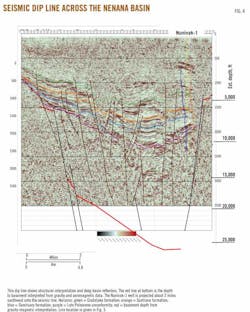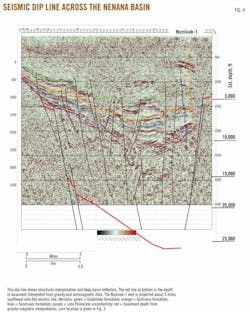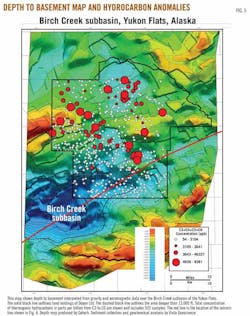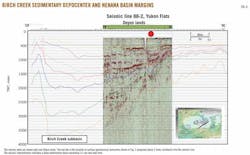Alaska's Interior rift basins: a new frontier for discovery
View Article as Single page
The density inversion used density indicated by logs from Nunivak-1 (11,075 ft TVD) for sedimentary fill and an assumed basement density of 2.80 g/cc. Increasing basement density to a less reasonable 2.95 g/cc decreases the basement depth to about 21,000 ft. An integration of gravity and aeromagnetic data to yield a depth to basement interpretation (not shown) is consistent with depths shown in Fig. 3.
The asymmetry of the Nenana basin is evident on the dip-oriented seismic line in Fig. 4. From an exploration point of view, the gentle western flank is generally considered more prospective than the steep eastern flank because of the potential for larger volume under closure and larger fetch areas.
Fig. 3 shows a structural nose extending to the NE in the northern basin between two sedimentary deeps. Hydrocarbons could potentially migrate onto this nose from three sides, and this feature is an attractive lead. Past exploration efforts, discussed below, focused on the southern part of the basin.
The structure of the Birch Creek subbasin in the Yukon Flats is shown in Fig. 5, a depth to basement interpretation based on gravity and aeromagnetic data. It shows a large deep in the southwest with basin depths to about 21,000 ft.
Using the depth contours on Fig. 5, sediment below 13,000 ft occurs over about 360 sq miles. This depth approximates the beginning of hydrocarbon expulsion in the Nenana basin, also discussed below. Using a depth of 6,000 ft for the top of the oil window, as suggested by Rowan and Stanley,1 dramatically increases the volume of thermally mature sediment. A seismic line through the Birch Creek subbasin is shown in Fig. 6.
Surface soil cores and lake bottom sediments were sampled in the Nenana basin and Yukon Flats. In the Yukon Flats, C2 through C6 thermogenic hydrocarbons were detected in lake sediment samples from the Birch Creek subbasin at the parts per million level (Fig. 5). Fluorescent spectral analyses detected C6 to C12 hydrocarbons that have similar spectral patterns to medium gravity oil.
In Fig. 5, no surface anomalies occur over the deep Birch Creek subbasin, but anomalies are associated with updip structural highs. These surface hydrocarbons are viewed as evidence of an active oil system with maturation, generation, and migration from the deep basin region onto the surrounding margin. The surface anomalies may occur where migration pathways intersect structural elements (for example, faults) associated with structural highs and divert towards the surface. Similar thermogenic hydrocarbon anomalies were detected near Stevens Village, another subbasin in the Yukon Flats, and the Nenana basin. Oil source rocks are thought to be thermally mature in each of these areas.
Displaying 2/6
View Article as Single page



